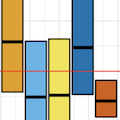Abstract
Infecting large portions of the global population, seasonal influenza is a major burden on societies around the globe. While the global source sink dynamics of the different seasonal influenza viruses have been studied intensively, its local spread remains less clear. In order to improve our understanding of how influenza is transmitted on a city scale, we collected an extremely densely sampled set of influenza sequences alongside patient metadata. To do so, we sequenced influenza viruses isolated from patients of two different hospitals, as well as private practitioners in Basel, Switzerland during the 2016/2017 influenza season. The genetic sequences reveal that repeated introductions into the city drove the influenza season. We then reconstruct how the effective reproduction number changed over the course of the season. While we did not find that transmission dynamics in Basel correlate with humidity or school closures, we did find some evidence that it may positively correlated with temperature. Alongside the genetic sequence data that allows us to see how individual cases are connected, we gathered patient information, such as the age or household status. Zooming into the local transmission outbreaks suggests that the elderly were to a large extent infected within their own transmission network. In the remaining transmission network, our analyses suggest that school-aged children likely play a more central role than pre-school aged children. These patterns will be valuable to plan interventions combating the spread of respiratory diseases within cities given that similar patterns are observed for other influenza seasons and cities.
